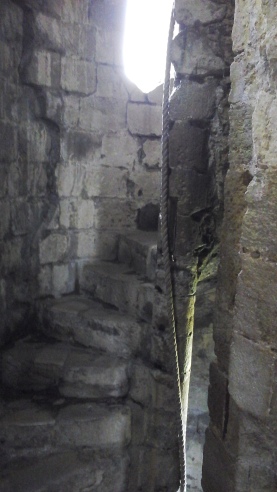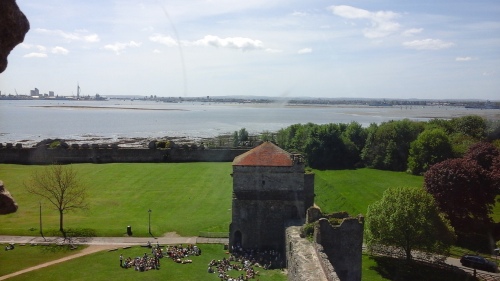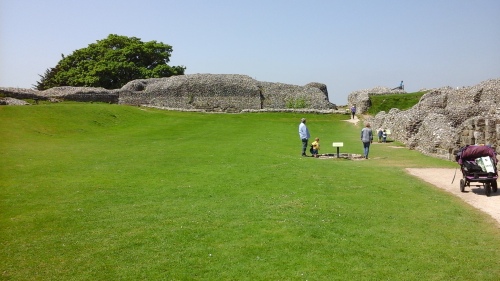Keeps are tall towers. They’re typically located on the opposite side of the bailey to the gatehouse, or in the centre of the castle. Early keeps, like the castles they stood in, were designed to intimidate the locals. They were also called donjons, from the Latin dominus – lord, or master. They were designed to be strong. It should be noted that not all towers are keeps. Towers on outer walls are just towers.
The best-known keep in England is the White Tower in the Tower of London. It was built in the 1080s by William the Conqueror and was whitewashed on the orders of Henry III in 1240.
When I visited Portchester Castle earlier in the year, I couldn’t get all of the keep into the frame to take a photograph, so I made a short video.
The keep at Portchester is not opposite the gatehouse. They are on diagonally opposite corners of the castle walls, which more or less form a square. In the 1130s the keep was built to a height just above the walls. Two more stories were added by the 1150s and a final floor in the 1320s. In the opening seconds of the video you can see the holes in a wall where the fourteenth-century staircase to the first-floor entrance used to be. They’re on the bottom right of the picture.
There are latrines and fireplaces in the keep, which show that it was intended for domestic use, rather than storage or primarily for defence.
Keeps were the last line of defence of a castle. They were made to be difficult to get into and once in it wasn’t easy for the enemy to get much further.

The stairs in the keep, Portchester Castle
The stairs are narrowest on the right-hand side by design. The attackers would not have been able to use weapons in their right hands effectively, whilst the defenders would. The defenders would also have the advantage of being above their attackers.
Fortunately for me, and most visitors, there are modern, wooden stairs within the keep. You only need to use the spiral stairs if you want to get to the very top of the keep. I was happy enough to enjoy the view from the highest point I could reach without using them.

Landgate and Portsmouth from the keep, Portchester Castle
This is what remains of the keep at Old Sarum. It’s directly opposite the main gate. The gap you can see to the right is the postern gate and we’ll get on to that in a later post.

Tower and courtyard house, Old Sarum
Old Sarum is on top of a hill. One of the reasons for putting a tall tower on top of a hill was obviously to make an impression on those who saw it. The rooms at the bottom of the keep were probably used for storage. They’re at ground level and the main entrance to the keep was above them, reached by steps. This was a feature of most keeps.

Steps to tower, Old Sarum
The room on the first floor of a keep was probably used by the lord of the castle to receive visitors and would have been decorated to impress.
Sources:
Castle – Marc Morris
Portchester Castle – John Goodall
Old Sarum – John McNeill
April Munday is the author of the Soldiers of Fortune and Regency Spies series of novels, as well as standalone novels set in the fourteenth century.
Available now:




Old Sarum didn’t fare well then, but Porchester looks strong.
LikeLiked by 1 person
Old Sarum stopped being used. It was originally a castle and a cathedral. A new cathedral was built in the valley and the stones of the castle and the old cathedral were stripped. If I remember, I’ll do a whole post about Old Sarum and its history. Portchester Castle on the other hand was used into the nineteenth century. The keep was used to hold French prisoners of war in the late eighteenth and early nineteenth centuries.
LikeLiked by 1 person
Having to fight your way up those stairs would have been grim. Being left-handed might have helped.
LikeLiked by 1 person
Now, that’s given me an idea. I have left-handed characters in my books, partly because I’m fascinated the whole idea of it and partly because I don’t do everything right-handed myself. I did fencing for a year and my partner was left-handed. It was really hard to work out what he was going to do, because everything was on the same side as my sword arm.
LikeLiked by 1 person
I suspect anyone training with weapons would aspire to be ambidextrous – or at least as near to it as they could get.
When we were kids having it out with wooden swords and shields adapted from washing machine lids, it seemed quite natural to swap our weapons round occasionally. Why? I don’t know, but now I wonder if in those pre-TV days (in NZ, anyway) it was a piece of lore passed down through generations of child communities.
LikeLiked by 1 person
That’s interesting. I don’t know that the same thing occurred to us. We were all very definitely right-handed in the 60s. It was only when I was in my early teens that I began to realise that a world created by right-handed people for right-handed people didn’t really work, even if you were right-handed. These days i use whichever hand makes the most sense.
LikeLiked by 2 people
I think we were all definitely right-handed too, though the ‘system’ had got past trying to force left-handers to write with their right hands. Perhaps we just did it for the extra challenge? Personally, I’m totally right-handed, but I can see there’d be all sorts of advantages in being more skillful with my left.
LikeLiked by 1 person
I can write legibly, just about, with my left hand, which is useful sometimes.
LikeLike
It would be! I once practised until I could write my name reasonably well, but that’s about it!
LikeLiked by 1 person
Great post a usual. Loved reading it and the keep has a commanding view.
LikeLiked by 1 person
Thank you. Yes, there was certainly a good view up there.
LikeLiked by 1 person
Did you ever see the UK production ‘Going Medieval’ presented by Mike Loades? Made in 2012. It was replayed recently on the History Channel so I recorded it because I thought a friend of mine might like it. We just finished watching it tonight.
Parts of the programme were filmed at Guédelon, and showed a murder hole in the keep where stones could be dropped on the heads of soldiers endeavouring to enter through a narrow passageway.
My friend was recently in Burgundy, but only briefly and a fair distance from Guédelon, so there was no time to visit.
LikeLiked by 1 person
I didn’t see it. I definitely want to go to Guedelon.
LikeLiked by 1 person
Thsnks again for sharing this fascinating information. The bit about the stairs makes perfect sense. It’s amacing that they managed so many details in the era.
LikeLiked by 1 person
I suspect there were lots of opportunities to find out what worked and what didn’t. There were hundreds of castles across England alone and each one would probably have improve on the one before it.
LikeLiked by 1 person
Enjoying this series on castles as I am a big fan! the Castle Keep is the only bit of Newcastle Castle which still stands to this day.
Rachael | https://rachaelstray.com/
LikeLiked by 1 person
They knew how to build to last in those days. Castles didn’t fall down, they had to be knocked down.
LikeLiked by 1 person
Exactly!
LikeLiked by 1 person
The very name Old Sarum conjures up romantic, misty visions. English names are so evocative; West Riding, Cold Harbour, Weston Super-Mare, Bury St, Edmunds, to name a few. Each place teems with interesting stories just begging to be told, and so many had a castle & keep somewhere in the vicinity. So much to learn!
Americans picked up on that in a hayseed sort of way when they came up with Deadwood, Tombstone, Tin Cup, Bent Fork, Hungry Horse, and other
esoteric head-scratchers. Sadly, not a castle nor keep in sight!
Love the little details you shared, and the children calling within Portchester’s
echoing walls added a great mental image of the lord’s children at play!
LikeLiked by 1 person
There were quite a few children on a school trip when I went to Portchester. They seemed to be having a good time.
When I come to write the post dedicated to Old Sarum, I’ll explain a bit more about the name.
LikeLike
Pingback: Anatomy of a Castle – The Moat | A Writer's Perspective
Fascinating!
LikeLiked by 1 person
Castles are amazing. It’s a shame more didn’t survive the Civil War.
LikeLike
I agree!
LikeLiked by 1 person
I think I’ve already subscribed on Blogspot but WordPress doesn’t play well with others. But I don’t want to encourage pop-ups!
LikeLike
To be honest, I’ve never had much joy with Blogspot myself, but if it works, that’s great.
LikeLike
Thank you, April, for the video of the keep of Portchester Castle. It was also a delight to hear your voice. I do love British accents, especially real ones, not ones put on by actors. 🙂
The detail in this post that was most struck me was about the reason that the stairs are narrower on the right–how canny! I’m so often impressed by the wealth of knowledge, experience, and engineering skill that went into early buildings.
I’ve been derelict in keeping up with your posts, which saddens me since I learn so much from them. In addition, you always seem to find the time to read mine, and I don’t want our blogging friendship to fall into a state of disrepair as bad as some of these medieval castles! So I will try harder. ❤
LikeLiked by 1 person
Thank you, Timi. I can reassure you that it’s my real accent.
Castle building developed a lot over a short period of time and the men responsible for them soon learned when things didn’t work and put it right the next time.
LikeLiked by 1 person
Pingback: Anatomy of a Castle | A Writer's Perspective